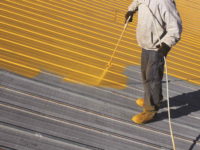Q&A: Catching Up on Coatings with the RCMA

Whether it’s in response to cost-cutting on capital projects or an increased desire to shrink a facility’s environmental footprint, roofing contractors are seeing a higher demand for coatings as a roofing solution. Contractors already in the market are driving that demand, and certain supply shortages are spurring new opportunities for roofers looking to grow in a specialized niche.
RC recently caught up with Dan Quinonez, executive director of the Roof Coatings Manufacturers Association (RCMA), and Chadwick Collins, RCMA technical director, to explore the state of the roof coatings market and what’s in store for the future. Here’s what we learned:
RC: How would you describe the state of the roof coatings market today?
RCMA: Stable and primed for growth. The growth we saw during the pandemic has created a base from which we continue to see steady increase. Roofing contractors are continuing to ask our members about offerings and expressing a desire to learn more about coatings.
RC: What was the biggest impact of the supply shortage and are we still feeling it?
RCMA: The biggest impact was really trying to respond to the domino effect as raw materials impacted production, which impacted order fulfillment at the same time as many other sectors of the roofing industry — as well as other industries — were doing the same thing. Similar supply shortages in the past were typically isolated to perhaps a singular material or a long sector or industry. For coatings, the biggest impact was trying to navigate all of it along with so many others.
Like many, though, we believe we are on the backend of the event. While there are still some occasional hiccups, many of our members have put systems in place to better respond to any remaining volatility.
RC: Where any lessons learned?
RCMA: One item that probably hasn’t been discussed is when a supply chain event like this occurs alongside regulatory reform. We spent a decent amount of time having to educate regulators on the strain of researching alternative formulations and new materials while nearly the entire supply chain apparatus was disrupted. Communication on how once-dependable estimated development timelines could not be utilized in this environment was essential, as well as finding ways to convey the industry’s commitment to regulatory discussions while trying to acknowledge the realities to implement those updates.
RC: How are your members better positioned to move forward from this?
RCMA: This industry has thrived on taking lessons learned from any shift in the market and continuing to keep them in mind moving forward. Like those times in the past, our industry continues to share new best practices and explore to opportunities to advance the industry forward.
RC: Are there still misconceptions about coatings in the roofing market today?
RCMA: Absolutely. At the same time, we are encouraged by the conversations our industry is having with different stakeholders, like contractors, consultants, and regulators. We are having more conversations about proper product selection and application methods that many times address the major concerns that individuals have about coating systems.
RC: What is the message to contractors not in the coatings market?
RCMA: We are looking forward to meeting you. Coatings are one of the easiest entry paths for a roofing product category and the industry survey data shows that contractors that already do coatings are seeing growth. Survey data also shows that contractors are looking at coatings to add to their portfolio. It is exciting to see so many discovering, or perhaps re-discovering, coatings and we are eager for those new contactors to do the same.
RC: How are your members contributing to the sustainability/resiliency conversation in roofing?
RCMA: On a basic level, many coating products provide reflective and emissive properties for the top surfaces of buildings, which contribute to those buildings’ energy demands for cooling and contributions to the urban heat island effect. Coatings also help extend a roof systems life cycle, which then reduces the number of times a roof would be discarded to a landfill during a building’s life cycle. On a higher level, the industry recognizes the need to provide data around these areas and our members have been developing industry average life cycle analysis and environment product declarations for multiple product categories. We look forward to completing that project and making those available to interested stakeholders.
RC: What are your biggest concerns looking ahead?
RCMA: Supply chain concerns cannot be discounted. The cascading effects for material availability and cost increases will continue to be top-of-mind for our members because the industry is only successful if all stakeholders can be successful.
Regulatory issues are also a priority. From the numbers of entities to interact with to the types of changes that are being considered make monitoring alone a laborious task. RCMA has really made a commitment to stay in communication with these entities and continue to provide a strong, data-driven voice for the industry.
RC: What are you proudest of about your organization and membership?
RCMA: The enthusiasm and commitment of our members. Our first event post-pandemic exceeded expectations on attendance and included many new members. As we look to finish 2022 strong on many fronts, we are excited as we look forward to 2023 and beyond.
Looking for a reprint of this article?
From high-res PDFs to custom plaques, order your copy today!






